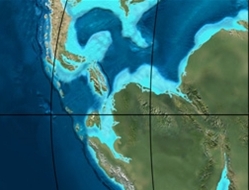| Guavio Formation | |
|---|---|
| Stratigraphic range: Tithonian-Berriasian ~ | |
| Type | Geological formation |
| Unit of | Cáqueza Group |
| Sub-units | Caliza de Las Mercedes Mb. Lutitas de Las Mercedes Mb. Caliza de Malacara Mb. Lutitas de Miralindo Mb. Conglomerado de Miralindo |
| Underlies | Macanal Formation |
| Overlies | Batá Fm., Girón Fm |
| Thickness | up to 1,000 m (3,300 ft) |
| Lithology | |
| Primary | Conglomerate |
| Other | Limestone, shale |
| Location | |
| Coordinates | 4°59′34.1″N73°28′53.8″W / 4.992806°N 73.481611°W |
| Region | Altiplano Cundiboyacense Eastern Ranges, Andes |
| Country | Colombia |
| Type section | |
| Named for | Guavio River |
| Named by | Rodríguez & Ulloa |
| Location | Alto de Miralindo, Guateque |
| Year defined | 1976 |
| Coordinates | 4°59′34.1″N73°28′53.8″W / 4.992806°N 73.481611°W |
| Region | Cundinamarca, Boyacá |
| Country | Colombia |
 Paleogeography of Northern South America 150 Ma, by Ron Blakey | |
The Guavio Formation (Spanish : Calizas del Guavio, Kicg) is a geological formation of the Altiplano Cundiboyacense, Eastern Ranges of the Colombian Andes. The formation consists of conglomerates, shales and limestones, dates to the Late Jurassic and Early Cretaceous periods; Tithonian to Berriasian epochs and has a maximum thickness of 1,000 metres (3,300 ft).

